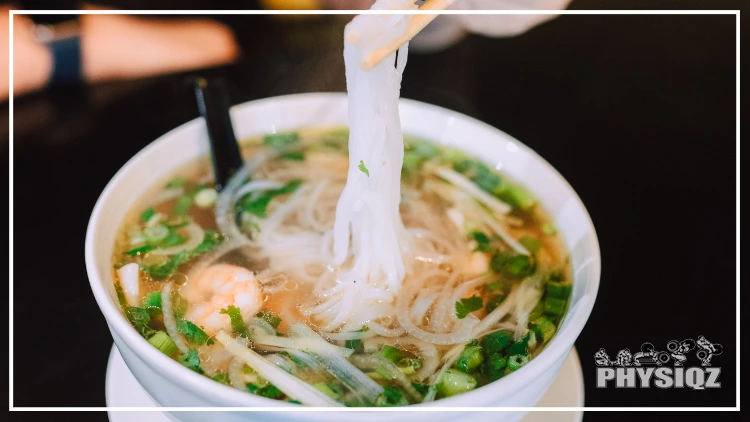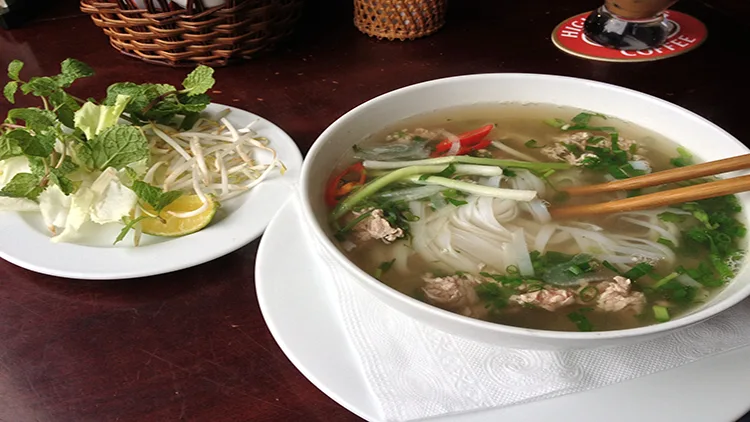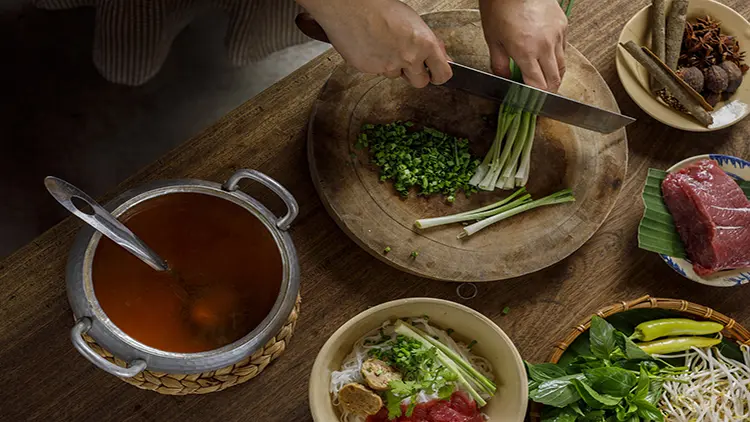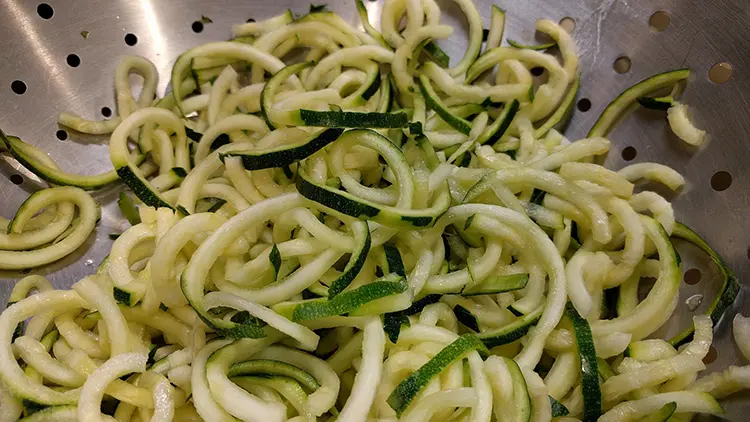
In most cases, pho is not keto approved because the noodles contain too many carbs.1 However, keto dieters can enjoy pho by opting for low-carb noodle substitutes and a sugar-free broth, which significantly reduces the carb content.
So without further ado, let’s take a look at how many carbs are found in most pho noodles, broth, and other ingredients to see everything that must be removed.
Then we’ll provide the ultimate guide on how to make pho keto friendly when ordering out, and a 0 carb broth recipe to make keto pho at home!
How Many Carbs Are in Pho?
Pho (pronounced “fuh”) soup prepared without any alterations is surprisingly high in carbohydrates, though most of those carbs come from just a single ingredient. It might be easy for someone to assume that Vietnamese pho soup is very low carb because at first glance it looks like a water or broth based dish, but traditional pho is made with rice noodles consisting of water and rice flour.

Source: Bill Kasman from Pixabay2
These rice noodles drastically raise pho carbs with 25 grams of carbs per 100 grams of noodles, so it should be avoided by anyone striving to maintain ketosis.
Someone following steps to lose weight in general or adhering to keto guidelines might reconsider having pho for dinner, but with some substitutions, it can still be enjoyed from time to time.
Are There Carbs in Pho Noodles & Broth?
While the pho broth itself only has a few carbs, if any, the rice noodles used in pho soup can instantly push someone to or beyond their daily carb limit and knock them out of ketosis. The carb count of the broth is dependent on the exact ingredients included and whether or not sugar is added in the recipe one is following.
Keep in mind that just 100 grams of rice noodles will already surpass the daily carb limit on keto, and most servings offered in restaurants or by street vendors will be much larger and even more dangerous to keeping one’s body in a state of ketosis.
Can Pho Fit into a Keto Diet?
Vietnamese pho is not conducive to dietary restrictions on keto if prepared traditionally, but thankfully modifications can be made to the recipe or ingredients to make it allowable on keto.
Since traditional pho is very low in fat, it isn’t very aligned with the concept of keto. Though it may be more in line with other trending diets, keto calls for foods rich in fats but low in carbs.
Though one can adapt their pho soup recipe to make it low carb, fats are important in keto because they’re used to fuel the body and keep one energized without relying on carbs.
Anyone starting a strength routine or leading an active lifestyle will need more fat than pho provides to keep their body going strong, so pho can be consumed but should be done so sporadically instead of as a go to dish.
Traditional pho is not suitable for a keto diet, but with substitutions to reduce carbohydrates and sugar, it can be enjoyed occasionally by someone following keto.
Is Noodle-Free Pho Keto-Friendly?
With rice noodles being the main contributing ingredient to the carb load in a customary Vietnamese pho dish, one might wonder if pho without the noodles is keto-friendly.
One adhering to the ketogenic diet for weight loss may be glad to learn that, yes, pho broth is usually keto approved whether chicken, beef, or other flavors.3 If prepared traditionally, pho both most often is made by boiling beef bones for many hours or even days, but this broth is exceptionally low carb and can even have a carb content of zero if sugar is withheld.
Sugar is not usually added in Vietnamese pho dishes, but the pho made available in American restaurants does; in fact, the kitchen often loads the broth with added sugar to appeal to the American sweet tooth and taste buds. One worried about the sugar content of the pho broth at a restaurant in the United States may want to ask their server how the broth is made prior to ordering, and request a sugar-free bowl if possible in addition to passing on the rice noodles.
This adaptation of withholding rice noodles and skipping the sugar can help those attempting to lose belly fat overnight, as the warm and aromatic soup can keep one feeling full for hours without a high calorie count.
A great alternative to the original pho soup recipe, spicy sate pho without noodles might fulfill one’s pho craving without bumping them out of ketosis. Pho sate puts a spin on the original pho dish by adding a chili peanut paste which makes the soup spicier and extra hearty, providing one with a more filling meal even without the noodles.
Are the Ingredients in Pho Broth Keto? What Ingredients Are in Pho Broth?
Most ingredients in pho broth are consistent between various recipes, but there are some more uncommon ingredients that add flare or different flavors and can be used if desired; let’s see which ingredients of the broth are keto.
The staple ingredients in pho broth that tend to be used in most recipes include:
- Beef bones or oxtail
- Ginger
- Star anise
- Fish sauce
- Coriander
- Cinnamon sticks
- Cloves
- Cardamon
Extra ingredients that are used more rarely or only in specialty pho dishes include mushrooms, broccoli, and onion. This depends completely on vendor or restaurant preparation and preference, so one unsure or concerned about certain allergies may want to check ingredients before ordering.
Of these ingredients, nearly all can be consumed on keto. Ginger, star anise, coriander, cinnamon, and cloves are all low carb herbs and spices allowed within keto rules.
Cardamom is fine in moderation, but should be limited as it is fairly rich in carbs.
Plain fish sauce is usually very low carb and keto-friendly but some restaurants–especially Asian restaurants–do tend to up the sugar content in their fish sauce, so moderation is the safest bet.
Finally, if your pho soup order or recipe includes onion, be sure to enjoy it in moderation. Onions are keto friendly to a certain extent, but the carbs can add up quickly.
Small servings are fine for keeping to ketosis; just don’t go overboard with adding these to the bowl.
What Meats Can Be Used in Keto Pho?
Beef bones are boiled to create the broth base in pho soup, but a variety of actual meats can be used in a pho dish.
The original and most common type of pho calls for thin slices of beef to be added to the broth and other ingredients. The beef in pho can be prepared in many different ways and can come from many parts of the cow, including flank, brisket, tendon, tripe, and oxtail.

Source: Trang Pham from Pixabay4
Aside from beef pho, this soup dish can also be made by following a chicken pho keto recipe or a seafood keto recipe which is often made with clams, squid, and shrimp. For anyone who likes pho but prefers not to have any meat whatsoever, they could use tofu as a meat substitute.
Since most fish and meats have few carbs, if any, most pho preparations that leave out the rice noodles are approved on the ketogenic diet.5
Nutritional Info for Pho Made Without Noodles
Although customarily included in this Vietnamese dish, pho noodles add too many carbs for those on keto. Let’s take a look at the nutritional value of pho soup made without these noodles.
No matter the meat or fish used, all of these are packed with proteins and are often rich in nutrients and minerals including B vitamins, iron, and zinc. Seafood can be instrumental in improving heart health, is anti-inflammatory, rich in omega-3 fatty acids, and contributes “good cholesterol” for added heart benefits.
For those looking to lose weight quickly while still enjoying meals like pho, it’s good to know that the herbs and spices in this soup are very low in calories and rich in nutrients, providing significant health and weight loss benefits, as explained below.
Ginger – reduces inflammation, treats nausea and boating, decreases motion sickness and morning sickness, boosts serotonin and dopamine, is loaded with antioxidants, improves digestion, fights fungal infections, and can improve blood sugar regulation
Coriander – boosts the immune system, is packed with antioxidants, promotes digestion and gut health, and may promote brain and heart health
Cinnamon – could improve insulin sensitivity, lowers blood sugar levels, and has antioxidant and anti-inflammatory properties
Star anise – has antifungal properties, promotes blood sugar regulation, may combat stomach ulcers, offers antibacterial and anti-inflammatory properties
Cloves – might improve liver health, reduces stomach ulcers, offers protection against cancers, rids the body of harmful bacteria, boosts bone health, keeps diabetes in check, and treats oral health issues
Cardamom – may alleviate insomnia, aids in urinary health issues, reduces joint pain, aids in gastrointestinal disorders, enhances blood circulation, and protects against stomach ulcers, infections, and chronic diseases with its anti-inflammatory properties
Whether intuitive eating for weight loss or following a stricter diet such as keto, it is always best to be aware of the foods one is consuming and what nutritional benefits (or lack thereof) they hold.
Best Low Carb Pho Recipe To Make at Home
Those following a keto low carb diet who still want to enjoy this staple Vietnamese dish are in luck. Here is a delicious low carb pho recipe with a 0 carb broth to try at home and better yet, it requires a much shorter preparation time than traditional pho; although it cuts some corners, it will save a lot of time and provide a beginner with a glimpse of how the original pho recipe is made while filling their home with the scent of aromatic spices.
Ingredient List: zucchini, thinly sliced meat or seafood of choice, marrow bones, yellow onion, fish sauce, cinnamon sticks, black cardamom pods, whole cloves, fresh ginger, star anise, coriander seeds, salt (sugar can be included if in a very small serving)
Optional Garnishings & Sauces: thai basil, cilantro, bean sprouts, lime, red chilis, sriracha, jalapenos, scallions, lemon, mint, carrots, bok choy (avoid hoisin sauce as it is shockingly high in sugar content)
Step 1: If preferred, boil or blanch the bones beforehand to ensure removal of any impurities or microorganisms.
Start the broth 6-8 hours in advance of the planned meal time using several various beef bones, including both marrow bones and meaty bones such as beef knuckles, knees, and other leg bones cut into little pieces. Oxtail can be added for intense flavor if desired.
Step 2: Halfway through heating the broth, add all herbs and spices from the above ingredient list. These flavors are vital to a good bowl of pho.
Step 3: Use a spiralizer, mandoline, or a julienne peeler to make substitute noodles out of zucchini (also called “zoodles”).
Step 4: Briefly warm the zoodles by boiling, sauteing, or baking to heat them without making them mushy. When warmed, move to a large serving bowl.
Step 5: Add paper thin slices of raw meat or fish of choice (yes, raw–the boiling broth added next will cook the slices; this is why it’s important they be extremely thin) on top of the zucchini noodles.
Step 6: Pour still-boiling broth over the bowl.
Step 7: Plate your garnishings on a side dish or add directly to your bowl of steaming hot pho.
Step 8: Using a wide spoon for the broth and chopsticks for the zucchini noodles, meat, and garnishings, enjoy!
How To Make Pho Keto Friendly
Anyone wondering how to make pho keto friendly has come to the right place; with some great-tasting low carb alternative noodles and skipping the sugar in their broth, one can easily adapt and learn how to make pho keto friendly.
Someone on a powerlifting program, rigorous workout program, or simply leading a busy and active lifestyle may want to reconsider cutting the sugar completely from their pho and perhaps opt for using a low carb sweetener such as monk fruit sweetener or xylitol instead, so as to quickly refuel and replenish after a workout routine without using actual sugar and breaking ketosis.
Though any noodles used will add carbs, 0 carb broth is ideal for keto and with low carb noodle substitutes, one can enjoy an almost traditional bowl of pho even on keto.
Pho can be keto-friendly if it is made with noodle and sugar substitutes.
Lowest Carb Noodle Choices for Keto Pho
Since noodles made with rice or flour are full of carbs and out of the picture for those on keto, let’s turn our focus to other low carb noodle and find the best keto noodle options one can use in their pho without kicking themselves out of ketosis.

Source: MootikaLLC from Pixabay6
Pho with shirataki noodles, zucchini noodles, heart of palm, spaghetti squash noodles, or bean sprouts are all fantastic options that are approved on keto.
Hearts of Palm: Considered a vegetable, hearts of palm are harvested from both the bud and the core of a variety of palm trees.7 Though the canned varieties can include other ingredients and drastically heighten sodium and carb content, raw hearts of palm or noodles made from hearts of palm are much better for keto.
In fact, a one cup serving of hearts of palm noodles contains just 4 grams of carbs. Hearts of palm are high in dietary fiber, zinc, magnesium, calcium, potassium, and B and C vitamins.
It can be enjoyed in salads, raw, or prepared in many other ways.
Shirataki/Konjac/Juroat Slim Noodles: One food with many interchangeable names, noodles made from the Asian root vegetable called konjac are a wonderful keto-friendly alternative to rice noodles. With just 6 carbs and close to 0 net carbs per 100 grams, the nutritional value of konjac noodles is otherwise unfortunately quite minimal.8
Advertised as a helpful aid in weight loss, this potato-like vegetable is both grain free and sugar free, as well as high in fiber yet low in calories. With few other nutrients to offer, these noodles do adhere to the carb limit for keto but don’t offer the fat needed on such a diet.
In its defense, two of the few health-promoting benefits of konjac are its interesting ability to create a protective layer within the intestines, and that it may help regulate metabolism.9 One noodle with many names, shirataki/juroat slim/konjac noodles can be enjoyed in pho but should not be a regularly used ingredient for someone in ketosis.
Zucchini Noodles (Zoodles): Zucchini noodles can be bought at the supermarket or one can make their own homemade zoodles with a mandoline, spiralizer, or julienne peeler. Without these tools, even a sharp chef’s knife or veggie peeler can do the trick.
While other ingredients can be added to flavor zucchini pasta dishes, zoodles used for pho don’t need anything else done to them after being cut and warmed–quick and simple.
Vietnamese pho soup is an earthy and aromatic dish with hearty ingredients and flavorful herbs and garnishments.
In summary, traditional pho is not keto-approved, but with a few easy alterations, even those on a keto diet can enjoy a steamy bowl of pho.
Frequently Asked Questions
Is Pho Diabetic Friendly?
The number of carbs in pho prevents this soup from being diabetic friendly, but low carb substitutions and passing on the sugar in pho broth can allow diabetics to enjoy this dish without spiking blood sugar.
Is Ordering Keto Pho at Restaurants Possible?
Ordering keto pho is as simple as checking on the sugar content of the broth the restaurant uses and opting for a low carb noodle alternative if available. If low carb noodles are off the table, anyone following keto can ask for no rice noodles in their bowl and could add extra bean sprouts instead for added substance without carbs.
What Are the Best Vietnamese Foods on Keto?
Though many Vietnamese foods are heavy on the rice and noodles making them carb loaded, salads, meats, and bean sprouts are great options to switch out and bring the carb count down.
Cucumber rolls with shrimp or other low carb seafood are also keto friendly, as are veggie-heavy banh mi salads, spring rolls made with zucchini noodles, and many other healthy low carb snacks and meals.
Does Pho Contain Sugar?
Yes, the fish sauce in pho tends to be very high in sugar; even the broth of pho is often made with sugar, especially in America. Alternative low carb sweeteners can be used instead.
Is Ramen or Pho Better for Keto?
A single serving bowl of traditional pho can come out to 45 carbs; even more shocking, the same size serving of ramen weighs in with 60 carbs. Anyone on keto will want to avoid these at all costs unless made with much lower-carb modifications such as shirataki noodles.
What Are the Best Soups on Keto?
While each of these will have variations from brand to brand and recipe to recipe, generally spicy cauliflower, broccoli cheese with bacon, vegetable soups, beef and veggie, miso, and cream of asparagus are all given the okay for keto.
References
1RODNAE Productions. “Cooked Food in the Bowl.” Canva. Accessed 11 April 2023. <https://www.canva.com/photos/MAEUr1grz18-cooked-food-in-the-bowl/>
2Kasman, Bill. “Free Image on Pixabay – Pho, Vietnamese Food, Restaurant.” Pixabay, 9 February 2014. Accessed 11 April 2023. <https://pixabay.com/photos/pho-vietnamese-food-restaurant-263127/>
3Harvard School of Public Health. (2023). Diet Review: Ketogenic Diet for Weight Loss. The Nutrition Source. Retrieved January 12, 2023, from <https://www.hsph.harvard.edu/nutritionsource/healthy-weight/diet-reviews/ketogenic-diet/>
4Pham, Trang. “Woman Cooking Pho Vietnamese – Free photo on Pixabay.” Pixabay, 3 November 2021. Accessed 11 April 2023. <https://pixabay.com/photos/woman-cooking-pho-vietnamese-food-6760877/>
5Masood, W., Annamaraju, P., & Uppaluri, K. (2022, June 11). Ketogenic Diet. National Institute of Health. Retrieved January 12, 2023, from <https://www.ncbi.nlm.nih.gov/books/NBK499830/>
6MootikaLLC. “Zucchini Noodle Noodles – Free photo on Pixabay.” Pixabay, 26 May 2017. Accessed 11 April 2023. <https://pixabay.com/photos/zucchini-noodle-noodles-zoodle-2340977/>
7Wikipedia, the Free Encyclopedia. (2022, December 20). Heart of Palm. Wikipedia. Retrieved January 12, 2023, from <https://en.wikipedia.org/wiki/Heart_of_palm>
8Ward, S. (2013, July 15). Low-cal ‘konjac pasta’: wonder noodles or a nutritional black hole? Endeavor College of Natural Health. Retrieved January 12, 2023, from <https://www.endeavour.edu.au/about-us/blog/low-cal-konjac-pasta-wonder-noodles-or-a-nutritional-black-hole/>
9Devaraj, R. D., Reddy, C., & Xu, B. (2018, December 23). Health-promoting effects of konjac glucomannan and its practical applications: A critical review. National Institute of Health. Retrieved January 12, 2023, from <https://pubmed.ncbi.nlm.nih.gov/30586587/>